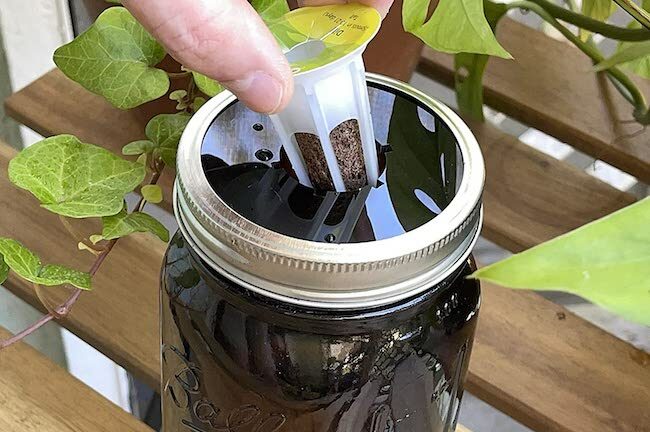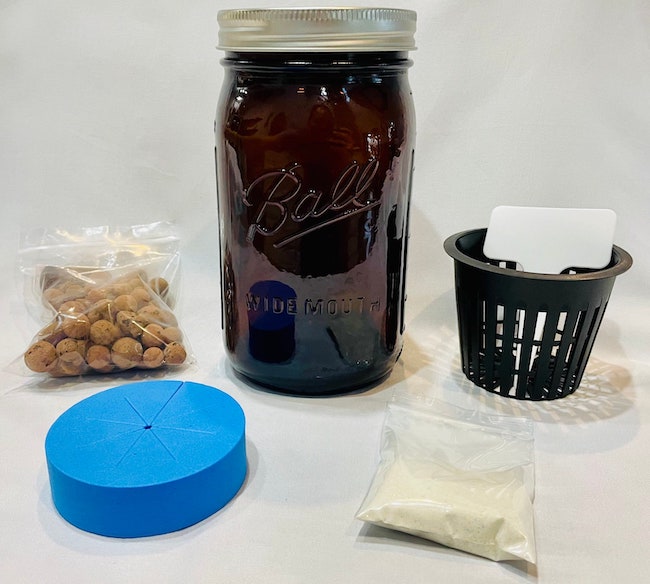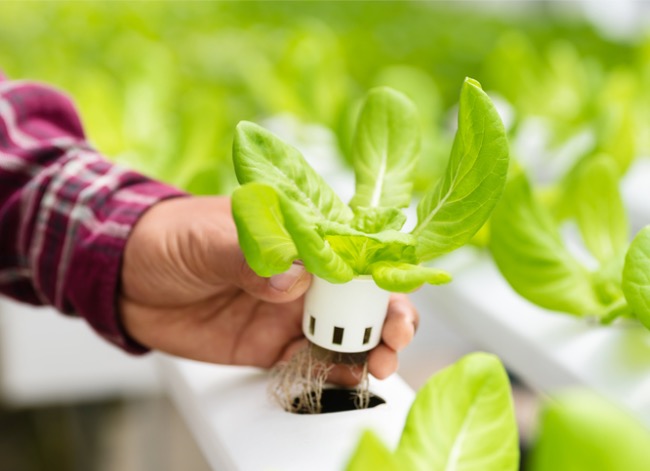

We may earn revenue from the products available on this page and participate in affiliate programs. Learn More ›
Hydroponics offers some advantages for plants that grow well in water. It seems counterintuitive, but hydroponics actually uses less water than growing plants in soil. It’s possible to grow more in less space, and because the gardener can control the nutrients, plants usually grow faster.
Kratky method hydroponics was developed by Bernard Kratky, a researcher at the University of Hawaii in the 1990s. The non-recirculating hydroponic Kratky method does not require pumps, electricity, or wicks. Instead, plants sit atop a “raft”—a netted pot containing a growing medium—that is fixed to the top of a small container or tank and filled with nutrient solution. As the plant grows, the nutrient solution level decreases to allow for air space.
1. The Kratky method is a form of passive hydroponics.
Considered a passive method because it doesn’t require pumps to circulate water and nutrients, Kratky hydroponics relies on a stagnant hydroponic solution and air space. Air stones and wicks are unnecessary. There’s no need to change out the water, nor is there a concern about rejuvenating oxygen for the plants.
As the plant grows, the water level drops, creating air space for the roots. When the plant is ready for harvest, the nutrient-filled water is nearly used up. It does not need replenishing; gardeners calculate the amount of solution needed by the plants and fill the tank only once.
After the plant is harvested, the gardener can refill the tank and place new transplants on top of the tank to start another crop. After three to five growing cycles, the tank should be cleaned.
Related: 11 Indoor Gardening Projects Absolutely Anyone Can Do
2. Kratky hydroponics requires five basic supplies.
The DIY Kratky method is inexpensive and requires only the following supplies to get started:
- Container. Depending on the size of the plant, you can start with something as small as a mason jar. Many gardeners opt for something larger, such as a 5-gallon bucket. Large-scale production might require a tank.
- Lid. The lid is very important in preventing evaporation of the nutrient solution and in supporting the plant above the water. Plastic or Styrofoam are suitable materials.
- Net pots. The webbed, plastic hydroponic growing container with holes in the bottom allows the nutrients to reach the roots and the solution to drain. These are essential to successfully growing plants hydroponically.
- Growing medium. The plants will need a pH-neutral growing medium, such as coconut fiber (a sustainable, organic, biodegradable medium made from shredding the inner pith of coconut husks), rockwool (or stonewool, which is a porous material made of spun basalt rock fibers), lightweight expanded clay aggregate (or clay pebbles, which are round pieces of heat-expanded clay), or perlite (a lightweight volcanic rock).
- Hydroponic fertilizer. Kratky method fertilizer is a mixture of Masterblend fertilizer, calcium nitrate, and magnesium sulfate in a 4-18-38 ratio. The amount must be carefully calculated to suit the size of the container and/or level of water.
- Additional supplies you may want to add include a pH control kit and a ppm meter. You can also find a complete Kratky starter kit like the one shown below available at Etsy.

3. You must calculate the amount of water and nutrients for the plant’s entire growth cycle at the beginning.
As opposed to the procedure used in recirculating hydroponic systems, the Kratky method does not require additional supplementation of water and nutrients during the growing period. Instead, the grower fills the container with enough water and nutrients to last the plant’s lifespan.
At initial setup, the bottom one-third of the net pot should be covered in water and Kratky hydroponics nutrients to keep the growing medium wet. The plant will take up the water as it grows, but as the water level declines, the plant’s roots will grow, continuing to reach the nutrient solution.
You must carefully calculate the amount of water and nutrients to account for the size of the container for effective growth.
Related: The Best LED Grow Lights for Indoor Plants and Veggies, Tested
4. An opaque reservoir container is best.
Opaque containers prevent sunlight from reaching a plant’s roots. The importance of this for hydroponic growing is to inhibit harmful algae and bacteria growth. Algae robs the water of nutrients and oxygen. If the plant fails to take up these vital substances due to algae growth, the plant will eventually die.
It’s possible to use a 2-liter soda bottle, milk jug, or even a mason jar like the one shown below (available at Etsy) for the Kratky method. However, if the container is clear, wrap it with opaque tape or paper to block sunlight.

5. Grow different types of plant in separate containers.
Because different plants have varying growth rates and nutritional demands, it’s best to grow a mono crop in each container. Grown together, deep-rooted vigorous growers like bok choy will starve out tender leaf lettuce because lettuce doesn’t grow as quickly and will eventually lose out. The lettuce must compete with the bok choy for nutrient water as the reservoir level declines, and the rapidly growing bok choy soaks up water faster than the lettuce does.
It may be possible to grow similar plants together if the plants have similar requirements. But if the lid supporting the net pots is slightly crooked, one plant could have more access to the nutrient water than the other, potentially outcompeting it.
Related: The Best AeroGarden to Bring Your Garden Indoors
6. Leafy greens and herbs grow well with Kratky method hydroponics.
Although some houseplants grow well hydroponically, the plants most commonly—and successfully—grown with the Kratky method are leafy greens and herbs. This method is not generally suitable for flowering or fruiting plants, which require additional nutrients to produce fruit.
Leaf crops are best for this hydroponic growing method; most leafy greens and herbs are small and fast-growing plants. For example, lettuce is one of the easiest plants to grow with Kratky hydroponics, thanks to its fast growth rate and high yield. Spinach and celery also grow quickly and do well in Kratky hydroponic setups. Basil and oregano are some of the easier herbs to grow hydroponically.

7. Large, thirsty plants like tomatoes and root vegetables like potatoes are not well suited for the Kratky method.
Not all plants are ideally suited to be grown using the Kratky method. Flowering and fruiting plants typically need additional nutrients for production, and some plants are especially “thirsty.” To help determine if a plant is suitable for hydroponic growth, you can use an app to learn about plant care.
Tomatoes, for instance, are very thirsty plants; they need energy to produce those juicy fruits. Tomatoes also require a large container for their roots, and the container would likely require regular refilling, due in part to the extended time it takes to get to harvest. In addition, the pH must hit a very specific range, as must the water temperature. Tomatoes also require a tremendous amount of light.
Root crops such as carrots, turnips, potatoes, and beets grow below the soil (in this case, water) line and don’t do well in Kratky hydroponic systems. Potatoes are susceptible to root rot. Carrots cannot grow successfully in net cups because the cups will restrict their growth.
However, if you want access to fresh leafy greens and herbs, the Kratky method is an easy solution.
